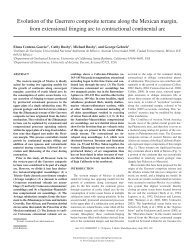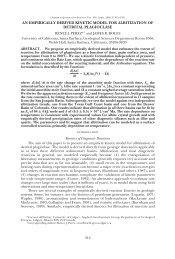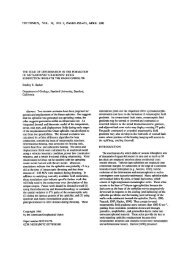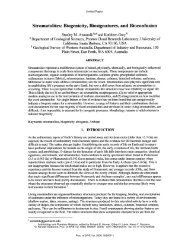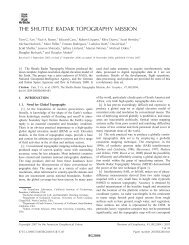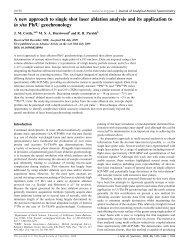Table 1 (continued)K.J. Spencer et al. / Chemical Geology 341 (2013) 84–10191P6824F1P6826C1P6826I1R9821D2R9823A1R9823FR9824B4R9825E1R9826HR9827I7R9828B2R9828C8R9828C11R9829C3R1617B1R3704A6Y0814E3Y0815J3Y0820C2Y0826I9Y0829J2Y1519C2Y1525A5Y1526AY1526F5Y1606C1Y1607D9Y1617B5Y1617G1Y1702A2Y1710C5Vågsøy; muscovite–garnet gneiss with amphibolite-facies shear bands. Titanite subhedral, 200 μm porphyroclasts. 388 MaUksenøya; single <strong>titanite</strong> in deformed, concordant hornblende–plagioclase leucosome. Low <strong>Pb</strong>*/<strong>Pb</strong> c ratio.Tresfjord; single 1 mm <strong>titanite</strong> rim on rutile in deformed, concordant hornblende–plagioclase leucosome. 401 Ma.SE Brattvåg; single 400 μm <strong>titanite</strong> in hornblende–biotite gneiss. Includes inherited, Precambrian component. 400 Ma.Ulsteinvik; eclogite overprinted <strong>by</strong> garnet granulite; moderate amphibolite-facies fabric. Subhedral 200 μm <strong>titanite</strong> rimmed <strong>by</strong> ilmenite. 388 MaHareidlandet; single 2 mm <strong>titanite</strong> in biotite–K-feldspar gneiss. Low <strong>Pb</strong>*/<strong>Pb</strong>c ratio.Runde; hornblende–K-feldspar amphibolite-facies mylonite. Titanite 200 μm subhedral rims on ilmenite. 384 Ma.Nerlandsøya; quartzofeldspathic ultramylonite. Titanite 100–200 μm anhedral twinned porphyroclasts. 382 MaGurskøya; annealed mylonitic hornblende–plagioclase gneiss. Titanite 50 μm anhedral, rare grains. 385 MaGurskøya; garnet–hornblende–biotite ‘Blåhø’ gneiss. Titanite, subhedral, 150–200 μm, biotite inclusions; included in hornblende. Low <strong>Pb</strong>*/<strong>Pb</strong> c ratio.Sandsøya; statically recrystallized hornblende–biotite granite mylonite. Titanite 100–150 μm anhedral porphyroclasts. 390 Ma.Sandsøya; zoisite+garnet+hornblende+clinopyroxene+plagioclase+quartz boudin-neck leucosome. Titanite 200 μm, anhedral, deformed. 382 MaSandsøya; biotite granitic mylonite. Titanite 50–200 μm anhedral. 379 MaSandsøya; biotite gneiss with amphibolite-facies shear bands. Titanite 100–200 μm subhedral porphyroclasts with rutile inclusions. 392 MaGurskøya; sillimanite gneiss. Titanite 100 μm subhedral–euhedral. 388 MaGurskøya; hornblende dioritic gneiss. Titanite 100 μm subhedral–euhedral. 390 MaBreimsvatnet; biotite–epidote schist. Amphibolite-facies protomylonitic fabric. Titanite 250–1500 μm, red–brown subhedral–anhedral porphyroclasts; some twinned. 968 MaBreimsvatnet; biotite–epidote quartzite with recrystallized amphibolite-facies mylonitic fabric. Titanite 50–250 μm euhedral clots. Low <strong>Pb</strong>*/<strong>Pb</strong> c ratio.Sandane; garnet–biotite–epidote gneiss. Moderate amphibolite-facies fabric. Titanite 50–250 μm subhedral–euhedral. Low <strong>Pb</strong>*/<strong>Pb</strong> c ratio.Lote; biotite–epidote gneiss with strong amphibolite-facies fabric. Titanite rare, 50 μm, anhedral. Low <strong>Pb</strong>*/<strong>Pb</strong> c ratio.Sandane; mylonitic muscovite schist. Titanite 175 μm euhedral inclusions in muscovite.Gloppenfjord; massive garnet amphibolite. Clots and trains of b100 m euhedral <strong>titanite</strong> grains. Low <strong>Pb</strong>*/<strong>Pb</strong> c ratio.Indre Nordfjord; biotite–epidote gneiss with strong amphibolite-facies fabric. Titanite 200–300 μm, brown, twinned. Low <strong>Pb</strong>*/<strong>Pb</strong> c ratio.Hornindal; deformed biotite granitic pegmatite. Titanite 50 μm subhedral grains rim ilmenite. Low <strong>Pb</strong>*/<strong>Pb</strong> c ratio.Hornindal; biotite–epidote–muscovite gneiss. Titanite subhedral 150 μm. Low <strong>Pb</strong>*/<strong>Pb</strong> c ratio.Hornindal; biotite–epidote gneiss. Titanite 250–500 μm brown subhedral porphyroclasts and 100 m euhedral grains. Includes inherited, Precambrian component.Low <strong>Pb</strong>*/<strong>Pb</strong> c ratio.Nordfjordeid; biotite–epidote gneiss with amphibolite-facies shear bands. Titanite 150–300 μm, brown, twinned. Low <strong>Pb</strong>*/<strong>Pb</strong> c ratio.Stårheim; biotite–epidote gneiss. Titanite subhedral 100 μm. 407 MaErvik; garnet–allanite granulite gneiss. Titanite 150 μm subhedral; some included in garnet. Includes inherited, Precambrian component.Gloppenfjord; albite–biotite–clinozoisite schist. Moderate amphibolite-facies fabric. Titanite 250–400 μm brown subhedral porphyroblasts; some twinned. Low <strong>Pb</strong>*/<strong>Pb</strong> c ratio.Gurskøya; hornblende–biotite gneiss. Titanite 5 mm anhedral in hornblende–plagioclase leucosome.(see below). Rare samples contain <strong>titanite</strong> porphyroclasts (8830A11,A0727C1, E9806G1, G9706G1, G9706N1, M8710E1), polygonized <strong>titanite</strong>(A0715M2, A0717M3, E9803K2, E9808H, K1725B3, K1725C, P5626H2,P5628U, P6806F1), mechanically twinned <strong>titanite</strong> (A0722E1, A0727N1,K5702D2), or otherwise deformed <strong>titanite</strong> (8911A5, A0727C1,A0727N1); such grains have chiefly Caledonian ages, but somepreserve inherited components. Titanite is an uncommon inclusion ingarnet (G9705R2, G9707A1, P5630A1, P5630A3, P6815E1, Y1617G1),hornblende (E9805K, P6817A1, R9827I7), and zoisite/epidote (P6805B3,P6815E1).2.2.1. Zr-in-<strong>titanite</strong> thermometryConsiderable thermobarometry has been done on the WGR, but muchof it has been on eclogite or on minerals of unknown age. To build a largerquantitative database of temperatures experienced <strong>by</strong> the WGRquartzofeldspathic rocks, we used electron-probe microanalysis (EPMA)to measure Zr in <strong>titanite</strong> (Figs. 6 and 7; Table 1; AppendixA),andthecalibration of Hayden et al. (2008) to calculate temperature. The pressurewas assumed to be 1 GPa, based on Terry et al. (2000), Labrousseet al. (2004), Walsh and Hacker (2004), andRoot et al. (2005); pressurescalculated in those papers range from 0.5 to 1.5 GPa, but have aTukey's biweight mean of 1.0±0.1 GPa (95% C.I.). The range and uncertaintyabout the mean introduce temperature uncertainties of ±53 °Cor ±11 °C, respectively. All of the rocks contain quartz, but few containrutile, in which case the quoted temperatures, calculated assuminga TiO2 =1, are maxima; note that rocks with ilmenite likely havea TiO2 >0.8 (Chambers and Kohn, 2012), in which case theZr-in-<strong>titanite</strong> temperature is too hot <strong>by</strong> b15°C.Inanattempttoreflectthis uncertainty, we assigned a minimum 1σ uncertainty of 15 °C toeach datum. The dataset for each sample was examined for subpopulationsusing the Sambridge and Compston (1994) unmixing algorithmimplemented in Isoplot (Ludwig, 2008); if the data describe a singlepopulation, Tukey's biweight mean is reported (Appendix A). The temperatureswere assigned a Proterozoic or Paleozoic age based on the U–<strong>Pb</strong> date of the <strong>titanite</strong> if available (realizing that diffusivities of <strong>Pb</strong> and Zrin <strong>titanite</strong> are different—but see Kramers et al. (2009); if the date of the<strong>titanite</strong> is unknown, assignment of the temperature to Proterozoic orPaleozoic was based on near<strong>by</strong> <strong>titanite</strong> with similar Zr contents (thesesamples are marked <strong>by</strong> “?” in Fig. 7).2.2.2. GeochronologyMore than one hundred samples were dated in this study (Tables 1,2 and 3; Fig. 6; Appendix A) using analytical techniques described in AppendixA; eight were analyzed <strong>by</strong> isotope-dilution thermal ionizationmass spectrometry (ID-TIMS) (Table 2), and the rest <strong>by</strong> laser-ablationmulticollector inductively coupled plasma mass spectrometry (LA-MC-<strong>ICP</strong>MS) (Table 3). Most of the samples dated <strong>by</strong> LA-MC-<strong>ICP</strong>MS were analyzedin thin section; several dozen large <strong>titanite</strong> crystals pluckedwhole from outcrops were analyzed in epoxy grain mounts. In eachcase, multiple spots from different <strong>titanite</strong> grains or grain fragmentswere dated. As explained in Appendix A, <strong>titanite</strong> dates determined <strong>by</strong>this method have an uncertainty of 2%. Titanite in ~15% of the sampleshas radiogenic-<strong>Pb</strong>/common-<strong>Pb</strong> ratios too low to generate meaningfuldates, but those samples are included in Table 1 for completeness.3. Results3.1. ThermometrySamples with Proterozoic <strong>titanite</strong> (see below) returned Zr-in-<strong>titanite</strong>temperatures of ~785–835 °C (red data, Fig. 7), consonant with their igneousor amphibolite- to granulite-facies mineralogy (recall that thesewere calculated assuming unit titania activity and a pressure of 1 GPa).Other samples with zoned <strong>titanite</strong> that might be Proterozoic (“?” inFig. 7; see below) gave generally similar temperatures. There is no spatialrelationship to the temperatures, implying that the peak Proterozoic (re)crystallization was everywhere of similar temperature. As noted above,our inability to know metamorphic pressure in each sample to betterthan ~1.0±0.5 GPa lends a potential uncertainty of ±53 °C to each measurement(although most samples will have an uncertainty closer to ±11 °C); samples without rutile may be too hot <strong>by</strong> ~15 °C.
92 K.J. Spencer et al. / Chemical Geology 341 (2013) 84–101Fig. 7. Zr-in-<strong>titanite</strong> temperatures (°C) inferred for the i) pre-UHP Proterozoic metamorphism (red), and ii) post-UHP metamorphic overprint (green). Temperatures inferred from otherstudies are shown in black: K, Krogh (1980);L,Labrousse et al. (2004);P,Peterman et al. (2009);R,Root et al. (2005);T,Terry et al. (2000);W,Walsh and Hacker (2004). “?” indicatestemperature is presumed to be of the age shown. The post-UHP, Barrovian metamorphic temperatures are contoured.Rocks with Scandian <strong>titanite</strong> (see below) have Zr-in-<strong>titanite</strong> temperaturesfrom ~625 °C to ~800 °C (green data, Fig. 7). The probability that<strong>Pb</strong> is more mobile than Zr within <strong>titanite</strong> means that some of thesetemperatures could correspond to Proterozoic events in spite of theirScandian U–<strong>Pb</strong> dates. The temperatures are lowest in the southernpart of the study area and highest near the center of the studyarea. Note that in spite of the uncertainty introduced <strong>by</strong> assumingP=1 GPa and a TiO2 =1, these temperatures are generally in agreementwith temperatures determined previously for the amphibolite-faciesoverprint using other methods (see references in the caption ofFig. 7); a quantitative location-<strong>by</strong>-location comparison isn't warrantedbecause of the unknown time and pressure represented <strong>by</strong> each temperatureand the many different methods used to determine temperaturein previous studies.3.2. TIMS <strong>dating</strong>Three samples analyzed <strong>by</strong> ID-TIMS gave common-<strong>Pb</strong> corrected,concordant dates of 384.2±8.1 Ma to 388.6±0.5 Ma (Table 2). Twoother samples yielded Precambrian dates.3.3. LA-MC-<strong>ICP</strong>MS U–<strong>Pb</strong> <strong>dating</strong>The majority of the samples dated <strong>by</strong> LA-MC-<strong>ICP</strong>MS have isotopicratios from multiple <strong>titanite</strong> grains that define a single 238 U/ 206 <strong>Pb</strong>–207 <strong>Pb</strong>/ 206 <strong>Pb</strong> isochron, indicating that, within the precision of the technique,the analyzed spots are of equivalent age. A substantial minorityof samples, however, have <strong>titanite</strong> with a mix of Precambrian andCaledonian dates. In some of these mixed Precambrian–CaledonianTable 2Thermal-ionization mass spectrometry data.Sample a Wt. (mg) U (ppm)238 U/ 206 <strong>Pb</strong> ±2σ207 <strong>Pb</strong>/ 206 <strong>Pb</strong> ±2σ206 <strong>Pb</strong>/ 204 <strong>Pb</strong> ±2σ Date (Ma) ±2σ Inherited age (Ma) bP6806G 1.7 34 9.72 0.02 0.1047 0.0014 339 17 600.8 c 2.9 ~950P6809B1 1.6 42 6.79 0.02 0.0859 0.0020 809 68 868.1 c 3.5 ~950P6815G1 1 27 14.03 0.03 0.1584 0.0025 133 34 389.6 c 1.8P6815G1 fsp 1 – – – 0.8800 0.0110 17.6 1.6 – –P6815H1 1 49 14.6 0.17 0.1343 0.0012 175 19 384.2 c 8.1Y1710C5 14.52 0.03 0.1334 0.00013 185 0.6 388.6 0.5Y1710C5 14.30 0.04 0.1446 0.00014 161 0.6 –Y1710C5 14.47 0.03 0.1359 0.00014 179 0.7 –Y1710C5 fsp – – 0.8721 0.00087 17.8 0.4 –Ratios are spike- and fractionation corrected, but not corrected for common <strong>Pb</strong>.a Sample fraction is <strong>titanite</strong> unless specified <strong>by</strong> ‘fsp’, in which case it is feldspar.b Inherited ages are approximated via an intercept through 400 Ma and the common-<strong>Pb</strong> corrected ratios of <strong>titanite</strong>.c Dates are <strong>titanite</strong>–feldspar or <strong>titanite</strong>–<strong>titanite</strong> isochrons, or 206 <strong>Pb</strong>/ 238 U dates calculated using a Stacey–Kramers common-<strong>Pb</strong> correction for an assumed age of 400 Ma.



